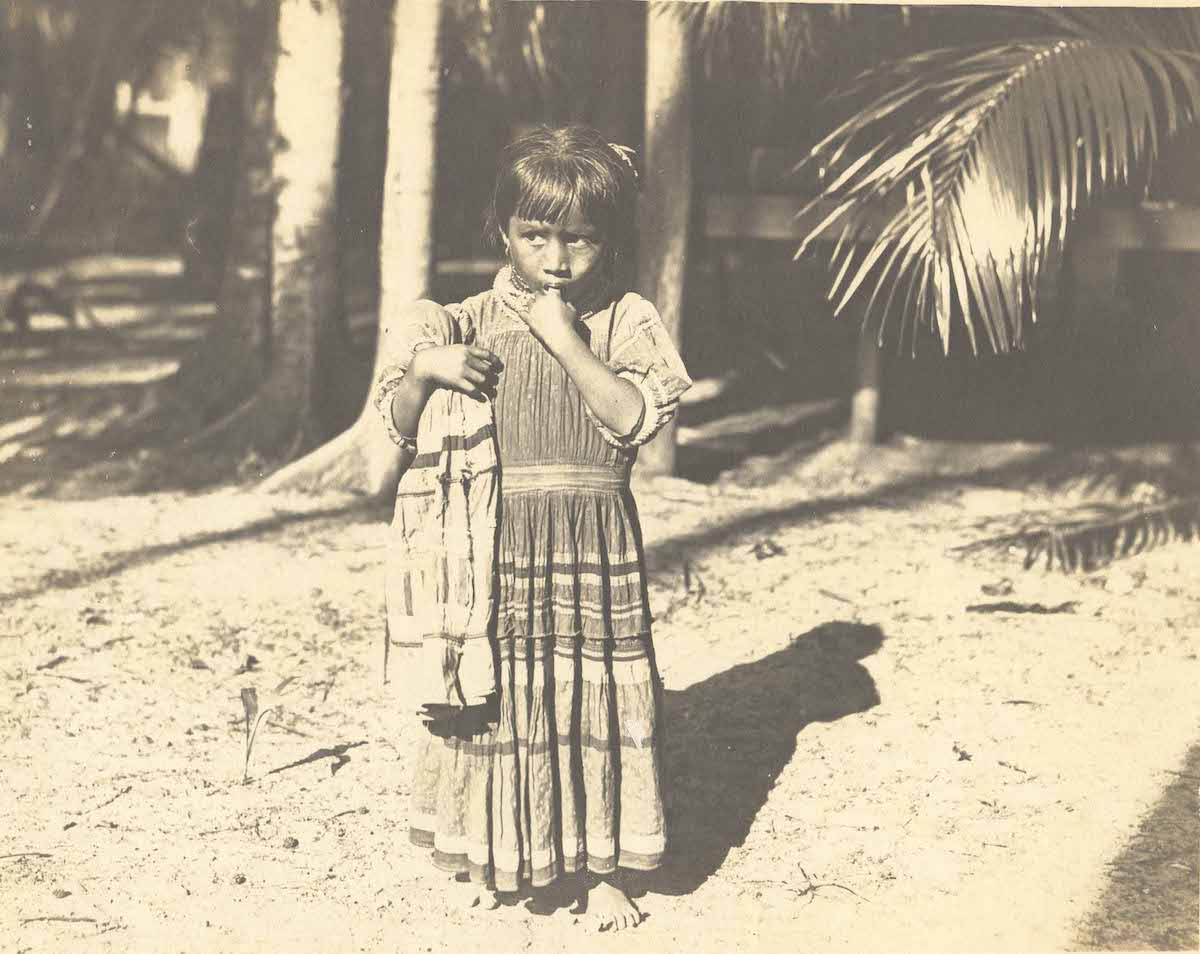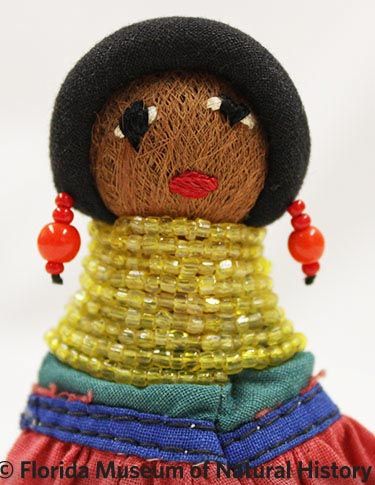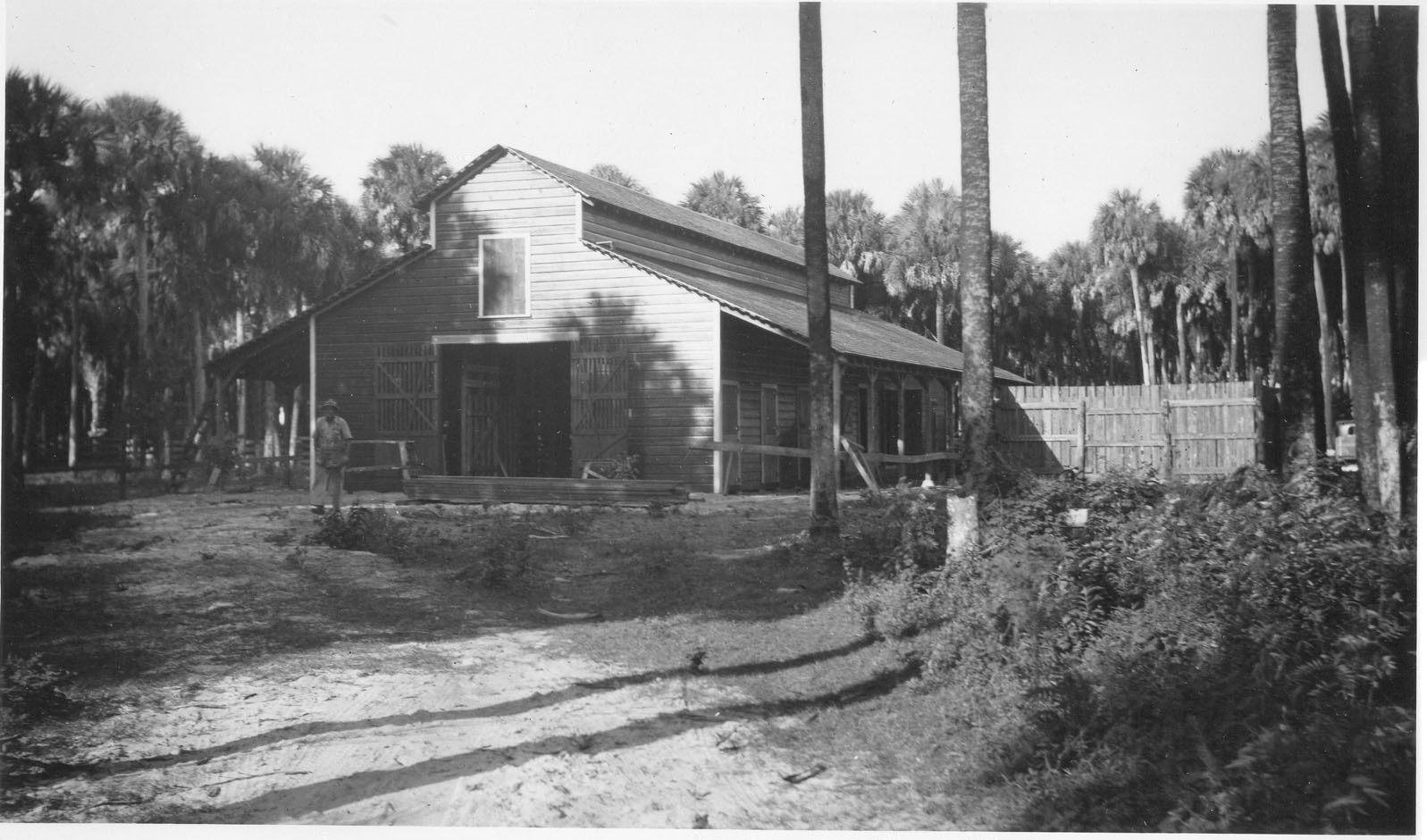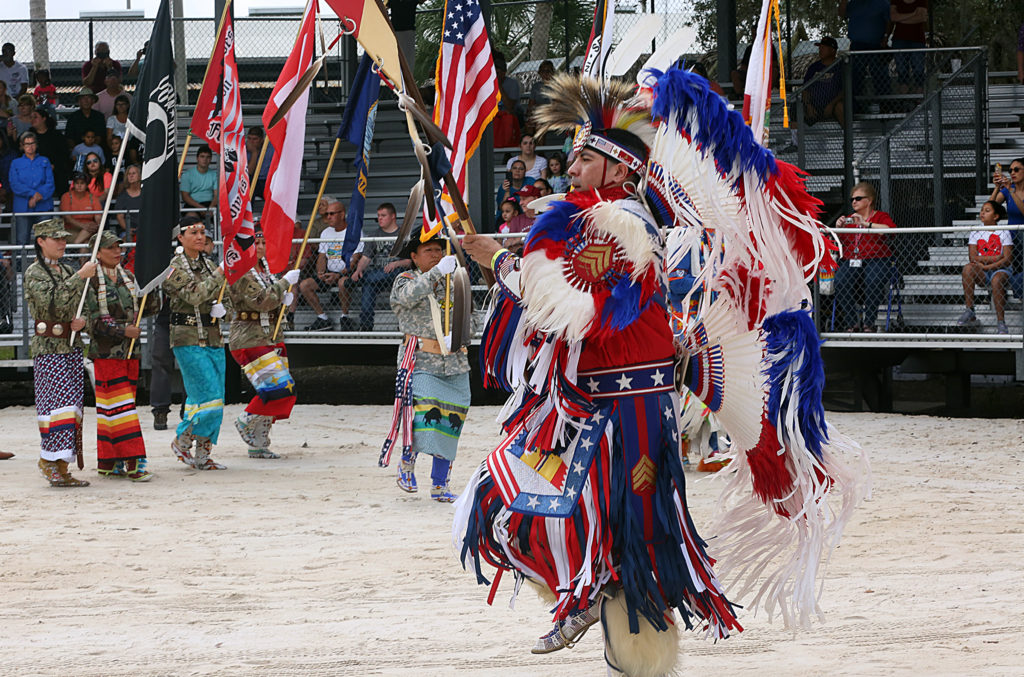
Before Barbie: Spotlight on Seminole Dolls
Before Barbie…there were Seminole dolls! Dolls are having their cultural moment right now. But, did you know they have been an important and celebrated part of Seminole culture much longer than Barbie has even been around? This week, we will be exploring the beauty, simplicity, and impact of Seminole dolls. Seminoles have been making them for their children for generations. But, as Seminole tourism began to take off in the early 1900s, Seminole dolls and other crafts became important tourist commodities. We will also be shining a spotlight on the University of Florida Seminole doll collection and other South Florida collections. Much of these are online for your perusal!
In our featured image this week you can see a young Seminole girl with a very early cloth head doll, circa 1900 (2001.32.1, ATTK Museum). Before the recognizable palmetto dolls you can still find today, Seminoles would make simple cloth or wooden dolls as children’s toys. As the tourist trade began to boom, Seminole palmetto dolls became a commonly sold style. Below, you can also see some young Seminole girls making palmetto dolls for sale at a tourist camp, circa 1930s.

State Archives of Florida/Becker
Crafts as Cultural Survival
Seminole dolls became an important cultural and economic commodity during their first real forays into the tourism sector. The fragmentation and draining of the Everglades took away many traditional Seminole lifeways. Tourism became a tool for cultural resilience and survival. As people began to flood into the Sunshine State, Seminoles capitalized on this increased population. Last year, we explored the connection with Seminole dolls and tourism in more detail. Seminoles began to make and sell Seminole dolls with distinctly Seminole features to tourists for income.
Eventually, after Tamiami Trail opened in 1928, many Seminole family camps popped up along the route. For income at these tourist camps, Seminoles would sell dolls, patchwork, and other crafts. Many dolls feature patchwork clothing, traditional hairstyles, beaded necklaces, and other identifiable Seminole features. Interestingly, many of these tourist dolls have made their way home to the Seminole Tribe of Florida in the last few decades.
In 2014, the Ah-Tah-Thi-Ki Museum acquired a large collection of Seminole dolls from Phyllis Cofrancesco. Cofrancesco got her first Seminole doll in the 1950s as a young girl living in Connecticut. She received it as a South Florida souvenir from her parents, and it sparked a lifelong love for the brightly colored, engaging crafts.
“I had never seen a doll made of tree bark. The clothing on the doll was much different than my ’50s clothing. It was a colorful cotton frock, and it had a creative design on it,” Confrancesco said of her first doll. By the time her collection made it to the Ah-Tah-Thi-Ki Museum, it had over 70 unique dolls spanning from the 1920s to the early 2000s. “I am proud to say they are now back home where they truly belong,” Cofrancesco said. Below, you can see Cofrancesco’s collection, which at the time brought the Ah-Tah-Thi-Ki Museum Doll Collection to over 250 unique dolls.

Cofrancesco’s Collection, via the Seminole Tribune
The University of Florida Collection
But, the magic and importance of Seminole dolls is recognized beyond just the Ah-Tah-Thi-Ki Museum collection. In Gainesville, the University of Florida and the Florida Museum hosts a wonderful online exhibit about their Seminole doll collection. Full of historic information about Seminole dolls and tourism, it traces both the physical construction of Seminole dolls as well as their cultural and historic impact. Seminole dolls have also changed over time, with trends in fashion, construction, and sale reflected through their ethnographic collection. “Seminole and Miccosukee dolls” the Collection description writes, “show the historical representation of both tribes and how their style has transformed over the years.” This collection is particularly unique in that it uses dolls to trace these shifts and changes. For example, how wooden dolls were quickly replaced with their more popular palmetto counterparts. Or, how shifting fashion trends are reflected in hairstyles and patchwork patterns.
In addition to exploring the many different types of Seminole dolls that have made their way into the cultural history, this collection also takes a close look at the indefinable Seminole features that make each doll unique. Exploring patchwork used for the doll clothes, and facial features and hairstyles seen on Seminole dolls, the collection takes a close look at how shifting fashion trends worn by Seminole men and women became part of doll construction.
Often, jewelry designs, hairstyles, and clothing reflected the fashion worn by Seminoles of the time in miniature form. This is apparent in the UF Seminole Doll Collection, where the sheer number of dolls allows even a casual observer to identify fashion trends and shifts. Below, you can see a close-up of a female Seminole doll in the UF Seminole Doll Collection. Note the many layers of beaded necklaces, as well as the drop earrings. She has a typical palmetto fiber face with stitched features.

UF Seminole Doll Collection, Florida Museum
Other Florida Online Collections to Explore
Slightly further south, another interesting and interactive Seminole doll collection has been made available to the public in a high-tech way. The University of South Florida Libraries and the Tampa Bay History Center collaborated to host an entirely online digital 3D model of a handful of Seminole dolls. These dolls are part of the Tampa Bay History Center’s Collection, and online visitors can rotate the scanned dolls 360 degrees, up, down, and zoom in and out. These high-quality 3D images are very detailed, letting you even zoom in to see the texture of the palmetto faces. This makes it easy for casual internet explorers to get a close-up look at doll construction. Peeking below the patchwork skirts, you can see that some feature traditional palmetto bodies that allow the doll to ‘stand’. Another in the same collection is significantly simpler, with only rick rack on the skirt and no body.
Beyond a flat image, this is an incredibly unique offering that provides a detailed picture of the scanned dolls. But, there are some limits to this scanned Collection. At the moment there are no scans of some rarer types of Seminole dolls, such as male dolls, combined crafts, or a pair. While limited, this is still and incredibly useful and educational online collection that we encourage you to explore!
What makes a Seminole doll?
Seminole dolls are especially unique in their construction, as they often use natural materials and fibers found locally in Florida. Initially, this was either a stylistic choice or to make sourcing materials easier. During the early days of organized Seminole tourism efforts when dolls first came about, utilizing natural, local materials was common and necessary. It is taboo to carve a realistic doll that resembles a person as “a realistic doll would bring harm to the person it looked like, as well as to the person who made it.” Thus, each doll is not an exact representation of a person, but more a stylized rendering that includes important cultural features like hairstyles, patchwork, and necklaces. Soon, tourist dolls would shift also to using palmetto fiber as the main material.
Typically, crafters make female dolls with a cone-shaped palmetto fiber body. The base may even be made of cardboard, to ease in it standing straight. Female dolls do not generally have limbs. Male dolls do tend to have palmetto fiber legs and arms. But, male dolls are also much more rare and harder to find. The maker stitches the palmetto fiber faces with cotton thread. So, what makes a Seminole doll is not only the doll itself, but the whole of what the doll embodies and represents. This includes not only traditional crafting practices and a traditional maker, but also uniquely Seminole features that reflect and uphold Seminole culture and history.
Combined Crafts
Often, Seminole dolls are combined with other crafts to create entirely unique and new items. Some of these include pin dolls (like the one shown below), doll head necklaces, and doll head baskets. Pin dolls are generally female and have a long skirt but no defined body. They are much smaller than full-size Seminole dolls. This allows the doll to be pinned to a shirt or clothing item, like the one below. Often, they have traditional hairstyles and necklaces. This doll features braided yarn hair. This became popular in the 1940s and 50s, as the younger generation of Seminole and Miccosukee were breaking away from traditional hairstyles and favoring modern ones.
Doll head necklaces are similar to pin dolls. They do not have the typical palmetto body, but instead a long skirt with a palmetto face and Seminole features. The maker then attached it to a strand of beads to create a wearable necklace, with the doll hanging almost as a pendant.

State Archives of Florida
Another interesting Seminole combined craft are doll head baskets and doll head pin cushions. These baskets combine two very important Seminole crafts: Seminole dolls and sweetgrass baskets. Often, the maker incorporates the doll head on the top of the basket lid. Then, an intricate basket provides a base for the lid. Doll head baskets take an incredible amount of skill and many hours to create. Similar in construction are doll head pin cushions. Below, you can see a doll head pincushion from the UF Seminole Doll Collection at the Florida Museum. The maker constructed this piece out of sweetgrass and palmetto fiber for the cushion part and beaded on both the doll head and the base.

UF Seminole Doll Collection, Florida Museum
Palmetto Fiber Dolls and Their Role
Beyond just a commodity, Seminole dolls have become a celebrated art form. The construction, stylistic choices, and even materials are deeply tied to Seminole culture and history. These dolls are a reflection of Seminole resilience and autonomy as they pivoted into tourism. Seminoles are the “Unconquered People.” Dolls are continued evidence of the truth in this moniker. Under the pressures created by the draining of the Everglades, and a changing Florida, Seminoles would pivot into tourism while still holding tight to their culture and way of life. Seminole dolls are Seminole; they hold Seminole features, and wear patchwork, necklaces, and traditional hairstyles. Each one represents something much more than a child’s toy or a souvenir. Rather, they reflect an entire culture, and one that, while changing with the times, refused to sacrifice their cultural identity and history.
We encourage you to explore, digitally and otherwise, the breadth of history and culture that can be found through Seminole dolls. The University of Florida Seminole Doll Collection at the Florida Museum is a fantastic resource to start, one that utilizes dolls from the collection to have conversations about shifting fashion trends, resilience, tourism, and the importance of art in upholding culture.
Author Bio
Originally from Washington state, Deanna Butler received her BA in Archaeological Sciences from the University of Washington in 2014. Deanna moved to South Florida in 2016. Soon, she began working for the Seminole Tribe of Florida’s Tribal Historic Preservation Office. Deanna was the THPO’s Archaeological Collections Assistant from 2017-2021. While at the THPO, Deanna worked to preserve, support, and process the Tribe’s archaeological collection. She often wrote the popular Artifact of the Month series, and worked on many community and educational outreach programs. She lives in Fort Myers, FL with her husband, son, and dog.




Diane Boone
I would like to add to my collection of Seminole dolls. Would you please suggest a place to purchase them (other than ebay).
I grew up in Tampa, graduated Fla.State and taught at Cape Canaveral. I have purchased some from the gift shop at the
Seminole casino in Tampa but understand that it has closed.
Thank you for your help.
Deanna Butler
Hi Diane! I would encourage you to follow us, the Ah-Tah-Thi-Ki Museum, and Okalee Village on social media. There are often vendors at some public events, as well as designated Marketplace events where vendors sell a variety of crafts. Two big events to put on your calendar are AIAC at the Ah-Tah-Thi-Ki Museum in November 2024, and the Seminole Tribal Fair & Pow Wow in Hollywood, FL from January 31-February 2, 2025.